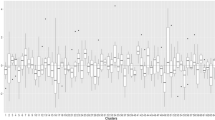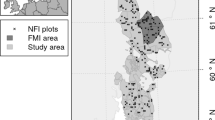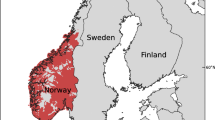Abstract
Forest inventories based on airborne laser scanning (ALS) have already become common practice in the Nordic countries. One possibility for improving their cost effectiveness is to use existing field data sets as training data. One alternative in Finland would be the use of National Forest Inventory (NFI) sample plots, which are truncated angle count (relascope) plots. This possibility is tested here by using a training data set based on measurements similar to the Finnish NFI. Tree species-specific stand attributes were predicted by the non-parametric k most similar neighbour (k-MSN) approach, utilising both ALS and aerial photograph data. The stand attributes considered were volume, basal area, stem number, mean age of the tree stock, diameter and height of the basal area median tree, determined separately for Scots pine, Norway spruce and deciduous trees. The results obtained were compared with those obtained when using training data based on observations from fixed area plots with the same centre point location as the NFI plots. The results indicated that the accuracy of the estimates of stand attributes derived by using NFI training data was close to that of the fixed area plot training data but that the NFI sampling scheme and the georeferencing of the plots can cause problems in practical applications.


Similar content being viewed by others
References
Andersen H-E, Breidenbach J (2007) Statistical properties of mean stand biomass estimators in a lidar-based double sampling forest survey. In: Rönnholm P, Hyyppä H, Hyyppä J (eds) Proceedings of ISPRS workshop laser scanning 2007 and Silvilaser 2007, September 12–14, 2007, Finland. International archives of photogrammetry, remote sensing and spatial information sciences, vol XXXVI, Part 3/W52, pp 8–13
Axelsson P (2000) DEM Generation from laser scanner data using adaptive TIN models. Int Arch Photogramm Remote Sens 33(Pt B4):110–117
Bitterlich W (1984) The relascope idea. Commonwealth Agricultural Bureaux, Farnham royal, 242p
Breidenbach J, McGaughey RJ, Andersen H-E, Kändler G, Reutebach SE (2007) A mixed-effects model to estimate stand volume by means of small footprint airborne lidar data for an American and a German study site. In: Rönnholm P, Hyyppä H, Hyyppä J (eds) Proceedings of ISPRS workshop laser scanning 2007 and Silvilaser 2007, September 12–14, 2007, Finland. International archives of photogrammetry, remote sensing and spatial information sciences, vol XXXVI, Part 3/W52, pp 77–83
Eid T, Gobakken T, Naesset E (2004) Comparing stand inventories based on photo interpretation and laser scanning by means of cost-plus-loss analyses. Scand J For Res 19:512–523. doi:10.1080/02827580410019463
Finley AO, McRoberts RE, Ek AR (2006) Applying an efficient k-nearest neighbor search to forest attribute imputation. For Sci 52:130–135
Gobakken T, Naesset E (2007) Assessing effects of laser point density on biophysical stand properties derived from airborne laser scanner data in mature forest. In: Rönnholm P, Hyyppä H, Hyyppä J (eds) Proceedings of ISPRS workshop laser scanning 2007 and Silvilaser 2007, September 12–14, 2007, Finland. International archives of photogrammetry, remote sensing and spatial information sciences, vol XXXVI, Part 3/W52, pp 150–155
Haara A, Korhonen KT (2004) Kuvioittaisen arvioinnin luotettavuus. Metsätieteen aikakauskirja 4/2004:489–508 (in Finnish)
Haara A, Maltamo M, Tokola T (1997) The k-nearest-neighbour method for estimating basal-area diameter distribution. Scand J For Res 12:200–208
Haralick RM, Shanmugam K, Dinsteein J (1973) Textural features for image classification. IEEE Trans Syst Man Cybern 3:610–621. doi:10.1109/TSMC.1973.4309314
Hollaus M, Wagner W, Eberhöfer C, Karel W (2006) Accuracy of large-scale canopy heights derived from LiDAR data under operational constraints in a complex alpine environment. ISPRS J Photogramm Remote Sens 60:323–338. doi:10.1016/j.isprsjprs.2006.05.002
Hollaus M, Wagner W, Maier B, Schadauer K (2007) Airborne laser scanning of forest stem volume in a mountainous environment. Sensors 7:1559–1577. doi:10.3390/s7081559
Holmgren J (2004) Prediction of tree height, basal area and stem volume using airborne laser scanning. Scand J For Res 19:543–553. doi:10.1080/02827580410019472
Holmström H, Nilsson M, Ståhl G (2001) Simultaneous estimations of forest parameters using aerial photograph interpreted data and the k nearest neighbour method. Scand J For Res 16:67–78. doi:10.1080/028275801300004424
Hyvönen P, Pekkarinen A, Tuominen S (2005) Segment-level stand inventory for forest management. Scand J For Res 20:75–84. doi:10.1080/02827580510008220
Jensen JLR, Humes KS, Conner T, Williams CJ, DeGroot J (2006) Estimation of biophysical characteristics for highly variable mixed-conifer stands using small-footprint lidar. Can J For Res 36:1129–1138. doi:10.1139/X06-007
Kainulainen A (2007) Relaskooppikoealojen käyttökelpoisuus puustotunnusten laserkeilaustulkinnassa. Faculty of forest sciences, master’s thesis in management of forest ecosystems. University of Joensuu, 43p (in Finnish)
Kainulainen A, Hyvönen P (2006) VMILASER maastokoealojen mittausohje. Finnish Forest Research Institute, Joensuu, p 76 (in Finnish)
Kangas A, Korhonen KT (1996) Application of non-parametric kernel regression and nearest neighbour regression for generalizing sample tree information. In: Spatial accuracy assessment in natural resources and environmental sciences: second international symposium. 21–23 May 1996, Fort Collins, CO, pp 631–638
Kilkki P, Päivinen R (1987) Reference sample plots to combine field measurements and satellite data in forest inventory. In: Remote sensing-aided forest inventory. Proceedings of seminars organised by SNS, 10–12 Dec 1986, Hyytiälä, Finland. Research Notes No. 19. Department of Forest Mensuration and Management, University of Helsinki, Helsinki, pp 209–215
Kilpeläinen H, Tokola T (1999) Gain to be achieved from stand delineation in LANDSAT TM image-based estimates of stand volume. For Ecol Manage 124:105–111. doi:10.1016/S0378-1127(99)00059-6
Laasasenaho J (1982) Taper curve and volume function for pine, spruce and birch. Commun Inst Forestalis Fenn 108:1–74
Laasasenaho J, Päivinen R (1986) Kuvioittaisen arvioinnin tarkistamisesta. Folia Forestalia 664:1–19 (in Finnish)
Leberl F, Gruber M, Ponticelli M, Bernoegger S, Perko R (2003) The ultracam large format aerial digital camera system. In: Proceedings of ASPRS 2003 conference, Anchorage, USA, on CD-ROM
Maltamo M, Eerikäinen K, Packalén P, Hyyppä J (2006a) Estimation of stem volume using laser scanning based canopy height metrics. Forestry 79:217–229. doi:10.1093/forestry/cpl007
Maltamo M, Malinen J, Packalén P, Suvanto A, Kangas J (2006b) Non-parametric estimation of stem volume using laser scanning, aerial photography and stand register data. Can J For Res 36:426–436. doi:10.1139/x05-246
Maltamo M, Korhonen KT, Packalén P, Mehtätalo L, Suvanto A (2007) A test on the usability of truncated angle count sample plots as ground truth in airborne laser scanning based forest inventory. Forestry 80:73–81. doi:10.1093/forestry/cpl045
McRoberts RE (2008) Using satellite imagery and the k-nearest neighbors technique as a bridge between strategic and management forest inventories. Remote Sens Environ 112:2212–2221. doi:10.1016/j.rse.2007.07.025
Means JE, Acker SA, Brandon JF, Renslow M, Emerson L, Hendrix CJ (2000) Predicting forest stand characteristics with airborne scanning lidar. Photogramm Eng Remote Sensing 66:1367–1371
Moeur M, Stage AR (1995) Most similar neighbor: an improved sampling inference procedure for natural resource planning. For Sci 41:337–359
Muinonen E, Maltamo M, Hyppänen H, Vainikainen V (2001) Forest stand characteristics estimation using a most similar neighbor approach and image spatial structure. Remote Sens Environ 78:223–228. doi:10.1016/S0034-4257(01)00220-6
Naesset E (1997) Estimating timber volume of forest stands using airborne laser scanner data. Remote Sens Environ 61:246–253. doi:10.1016/S0034-4257(97)00041-2
Naesset E (2002) Predicting forest stand characteristics with airborne scanning laser using a practical two-stage procedure and field data. Remote Sens Environ 80:88–99. doi:10.1016/S0034-4257(01)00290-5
Naesset E (2004a) Practical large-scale forest stand inventory using a small airborne scanning laser. Scand J For Res 19:164–179. doi:10.1080/02827580310019257
Naesset E (2004b) Accuracy of forest inventory using airborne laser scanning: evaluating the first Nordic full-scale operational project. Scand J For Res 19:554–557. doi:10.1080/02827580410019544
Naesset E, Gobakken T, Holmgren J, Hyyppä J, Hyyppä H, Maltamo M, Nilsson M, Olsson H, Persson Å, Söderman U (2004) Laser scanning of forest resources: the Scandinavian experience. Scand J For Res 19:482–499. doi:10.1080/02827580410019553
Naesset E, Gobakken T, Kangas A, Maltamo M, Bollandsås OM, Aasland T, Solberg S (2006) Extending and improving methods for operational stand-wise forest inventories utilizing multi-resolution airborne laser scanner data. In: Proceedings of the international conference Silvilaser 2006. November 7–10 2006. Ehime Prefectual Convention Hall Matsuyama, Japan, pp 75–79
Niska H, Rantamäki M, Hiltunen T, Karppinen A, Kukkonen J, Ruuskanen J, Kolehmainen M (2005) Evaluation of an integrated modelling system containing a multi-layer perceptron model and the numerical weather prediction model HIRLAM for the forecasting of urban airborne pollutant concentrations. Atmos Environ 39:6524–6536. doi:10.1016/j.atmosenv.2005.07.035
Packalén P, Maltamo M (2006) Predicting the volume by tree species using airborne laser scanning and aerial photographs. For Sci 52:611–622
Packalén P, Maltamo M (2007) The k-MSN method in the prediction of species specific stand attributes using airborne laser scanning and aerial photographs. Remote Sens Environ 109:328–341. doi:10.1016/j.rse.2007.01.005
Sironen S, Kangas A, Maltamo M, Kangas J (2003) Estimating individual tree growth with non-parametric methods. Can J For Res 33:444–449. doi:10.1139/x02-162
Thomas V, Treitz P, McCaughey JH, Morrison I (2006) Mapping stand-level forest biophysical variables for a mixedwood boreal forest using lidar: an examination of scanning density. Can J For Res 36:34–47. doi:10.1139/x05-230
Tomppo E (2006a) The Finnish National Forest Inventory. In: Kangas A, Maltamo M (eds) Forest inventory. Methodology and applications. Managing forest ecosystems, vol 10. Springer, Dordrecht, pp 179–194
Tomppo E (2006b) The Finnish multi-source National Forest Inventory—small area estimation and map production. In: Kangas A, Maltamo M (eds) Forest inventory. Methodology and applications. Managing forest ecosystems, vol 10. Springer, Dordrecht, pp 195–224
Tomppo E, Halme M (2004) Using coarse scale forest variables as ancillary information and weighting of variables in k-NN estimation: a genetic algorithm approach. Remote Sens Environ 92:1–20. doi:10.1016/j.rse.2004.04.003
Tuominen S, Pekkarinen A (2004) Local radiometric correction of digital aerial photographs for multi source forest inventory. Remote Sens Environ 89:72–82. doi:10.1016/j.rse.2003.10.005
Uuttera J, Hiltunen J, Rissanen P, Anttila P, Hyvönen P (2002) Uudet kuvioittaisen arvioinnin menetelmät—arvio soveltuvuudesta yksityismaiden metsäsuunnitteluun. Metsätieteen aikakauskirja 3(3002):523–531
van Aardt JAN, Wynne RH, Oberwald RG (2006) Forest volume and biomass estimation using small-footprint lidar-distributional parameters on a per-segment basis. For Sci 52:636–649
Veltheim T (1987) Pituusmallit männylle, kuuselle ja koivulle. Metsänarvioimistieteen pro gradu -tutkielma. Helsingin yliopisto. 59p (in Finnish)
Author information
Authors and Affiliations
Corresponding author
Additional information
Communicated by K. Puettmann.
Rights and permissions
About this article
Cite this article
Maltamo, M., Packalén, P., Suvanto, A. et al. Combining ALS and NFI training data for forest management planning: a case study in Kuortane, Western Finland. Eur J Forest Res 128, 305–317 (2009). https://doi.org/10.1007/s10342-009-0266-6
Received:
Revised:
Accepted:
Published:
Issue Date:
DOI: https://doi.org/10.1007/s10342-009-0266-6




